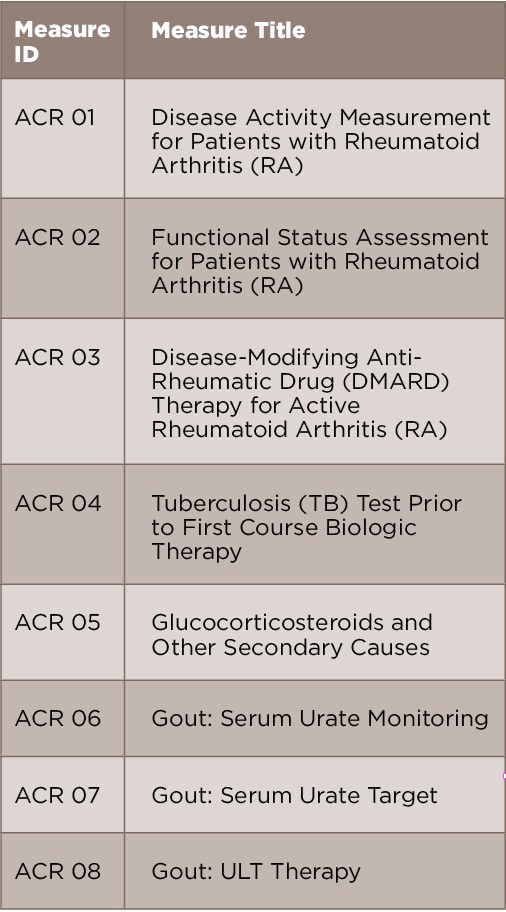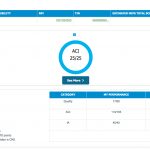The ACR has been at the forefront of helping rheumatologists meet practice demands, including federal reporting requirements. The first registry that helped meet these requirements was the Rheumatology Clinical Registry (RCR), and it facilitated quality reporting, but required manual entry of required data. More recently, ACR has contracted with FIGmd to create a tool that helps rheumatologists capture, analyze and share important clinical practice information without creating the burden of manual data entry. Moreover, the ACR wants to promote quality using indicators that are relevant to rheumatologist practices.
RISE (Rheumatology Informatics System for Effectiveness) is an online registry that automatically captures data from individual electronic health record systems (EHRs) and provides information that meets the new federal reporting requirements of the Medicare Access and CHIP Reauthorization Act of 2015 (called MACRA, for short). Currently, RISE captures data on more than 2.5 million patient encounters. RISE can deliver analytics and practice insights to rheumatology health professionals. RISE has become an integral part of more than 200 rheumatology practices, both large and small. And as we prepare for the implementation of paradigm-shifting federal legislation, this powerful, high-tech tool, which the ACR does not charge its members to utilize, is more important than ever.
In my April column, I wrote about MACRA. Signed into law in April 2015, MACRA has broad implications for rheumatologists. Not only does the legislation fundamentally alter Medicare reimbursement, but it also requires physicians to choose one of two payment paths by Jan. 1, 2017. One option is the so-called Merit-Based Incentive Payment System (MIPS), in which physician payments will be adjusted on the basis of performance and patient outcomes.
RISE-ing to the Need
Here’s where RISE comes in. If rheumatologists are to be paid on the basis of performance measures, they need to know how they’re performing. And, fortunately, the data analytics that RISE provides can do just that; RISE allows users to self-assess, by analyzing data on demographics, medications, lab data, disease activity, functional status and other metrics directly from their electronic health record. In addition, clinicians can benchmark these data within the group practice and/or nationally to other practices connected to RISE. With these powerful analytics, physicians can keep a watchful eye on key clinical quality measures, align themselves with best practice standards and understand what they need to do to not only meet, but exceed national averages.
RISE, therefore, allows providers to see themselves in the context of clinical quality improvement. The registry lets a practitioner review current quality metrics and adjust their practice delivery appropriately to optimize quality care for the patients they serve.
This tool is being utilized by nearly 650 ACR members every day, and as the data analytics become routine, RISE gives us the promise of quality care delivery. For example, in a large physician practice that has been using RISE for nearly 18 months, individual physicians can review interactive dashboards, and the practice manager pulls performance reports on individual providers. Performance metrics are used to focus on areas for improvement and develop improvement plans.
Small practices can do the same, channeling RISE data analytics into better care. In this way, RISE empowers small practices, by providing analytics that a small practice may not have had access to before RISE.
Consider this practical scenario. Say I’m a physician scoring below the national average for prescribing disease-modifying anti-rheumatic drugs for patients with rheumatoid arthritis (RA). I can log in to RISE, see which patients met the intended measure, which patients were exclusions and which patients should have met the measure but didn’t. This can help me pinpoint the underlying cause of the performance metric and make adjustments as needed.
Put simply, RISE is an invaluable and incredibly useful feedback tool for rheumatologists, especially in a healthcare environment highly influenced by MACRA. As a practicing rheumatologist, I genuinely believe this tool will change the way we manage care. Although introducing a new digital data collection system may sound arduous and time consuming, once a practice goes through the initial process to connect to the registry and the data validation steps, very little maintenance work is required. Practices that have connected to RISE appreciate the feedback that RISE can deliver, and clinicians continue their routine practice and documentation. The ACR’s RISE team works with the physicians to make sure the data continue to be accurately mapped to the registry.
Variability in medical records is not a problem using RISE. Maybe one rheumatologist inputs disease activity scores in a structured assessment section, and you put your scores into differently structured notes. Fortunately, most differences don’t matter. Once providers sign up for RISE, the RISE team starts the mapping process with the practice. The RISE connection process unfolds over several conversations with your practice physicians. The RISE team learns exactly how and where you document information in your EHR to make sure that all the relevant data from your practice are carried over to the RISE registry to capture the necessary quality scores. The mapping process requires some time and effort from your practice on the front end, but is well worth the value gained and money saved later on.
Qualified Clinical Data Registry
As a qualified clinical data registry (QCDR), RISE has additional benefits for rheumatologists who choose to follow the MIPS payment pathway under MACRA. Responding to advocacy from the ACR and other groups, the CMS (Centers for Medicare & Medicaid Services) has agreed to allow the use of QCDRs—including RISE—to report on three of the four required reporting categories under MIPS. This means that rheumatologists who use RISE for MIPS reporting do so seamlessly after signing an agreement allowing the ACR to submit data to CMS on their behalf. Automated and streamlined MIPS reporting through RISE will eliminate a significant hassle for physicians and allow the rheumatologist to focus on quality delivery of care to their patients.
Additionally, the ACR team expects that participation in a qualified registry like RISE will allow rheumatologists to earn credit in the Clinical Practice Improvement component of MIPS and possibly other components, as well.
Rheumatology-Specific Quality Measures
With future payments so closely tied to quality and performance measures, the ACR is also working hard to ensure CMS quality measures accurately reflect the patients we treat and the medicine we practice. The ACR has dedicated significant time and energy to developing quality measures that are specific to rheumatology. You will not find these measures in any other registry, and we are actively working with CMS to ensure these and other rheumatology-specific measures are included in MIPS.
Conclusion
Ultimately, the benefits of RISE are vast. Using RISE means convenience, quality and access to valued data and information. Taken together, this means better, more efficient care and more predictable payments in the future. We urge all ACR members to sign up* for RISE and reap the full benefits. In this way, together we can Advance Rheumatology!
 Joan M. Von Feldt, MD, MSEd, FACR, FACP, is president of the ACR and a professor of medicine at the Perelman School of Medicine at the University of Pennsylvania. She is also staff physician at the Philadelphia VA Medical Center.
Joan M. Von Feldt, MD, MSEd, FACR, FACP, is president of the ACR and a professor of medicine at the Perelman School of Medicine at the University of Pennsylvania. She is also staff physician at the Philadelphia VA Medical Center.
Author’s note: *Signing up to participate in RISE can be accomplished by completing a form on the ACR website at or emailing staff directly at [email protected].


